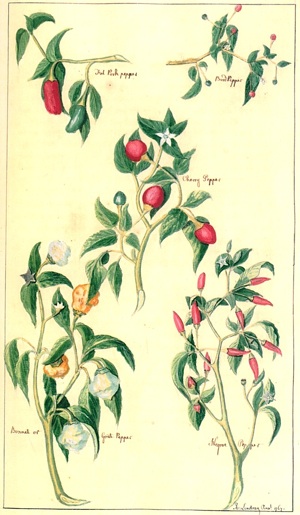 Many folk remedies are made with chile peppers, as I detailed with two coauthors in The Healing Powers of Peppers (Three Rivers Pres, 1998). We discovered chile peppers being used in infusions, syrups, teas, tinctures, liniments, ointments, poultices, salves, and oils. Perhaps the most unusual treatments were two hot sauces, one to improve the appetite and the other to combat scurvy.
Many folk remedies are made with chile peppers, as I detailed with two coauthors in The Healing Powers of Peppers (Three Rivers Pres, 1998). We discovered chile peppers being used in infusions, syrups, teas, tinctures, liniments, ointments, poultices, salves, and oils. Perhaps the most unusual treatments were two hot sauces, one to improve the appetite and the other to combat scurvy.
Mandram: Cucumbers and Chiles
While searching Google Books, I found several references to a West Indian hot sauce that was used to make people hungry. “A mixture of sliced cucumbers, shallots, or onions, cut very small, a little lime juice, and Madeira wine, with a few pods of bird pepper well mashed, and mixed with the liquor, is reckoned an unfailing stimulant to the appetite in the West Indies, and is called man-dram,” wrote William Rhind in A History of the Vegetable Kingdom (London: Blackie & Son, 1868). A much earlier observer, Edward Long noted in his 1774 book, The History of Jamaica (London: T. Lowndes), “These [bird] peppers are used liberally in the West-Indies, gathered fresh from the bush, generally before they are ripe; though the bird-pepper has the best flavour in its mature state. Perhaps they are necessary, in this climate, to assist digestion, promote the tonic motion of the bowels, invigorate the blood, and correct the flatulency of vegetable aliments. The mixture, called man-dram, seldom fails to provoke the most languid appetite. The ingredients are, sliced cucumbers; eschalots, or onions, cut very small; a little lime-juice, and Madeira wine; with a few pods of bird or bonnet-pepper, well-mashed, and mixed with the liquor.”
The earliest real recipe I could find for mandram was published in Cassell’s Dictionary of Cookery (London: Cassell, Petter, Galpin & Co., 1883): “Mandram Sauce.—Mince two shallots or a middle-sized onion as finely as possible. Chop or slice a cucumber, and let the vegetables stand in water for a few minutes; then drain them dry. Sprinkle lightly with salt, and add the cucumber, a small pinch of cayenne, and part of a capsicum, sliced, with a table-spoonful of vinegar, and two of white wine. If the cucumber be sliced, the onion should be chopped, and vice versa. Time, five minutes to drain the cucumber.”
Since cucumbers have long been recommended as a digestive aid in herbal medicine, it makes sense that they would be included in this condiment. The purpose of the chile peppers is somewhat of a mystery, unless the original intent was to make a hot sauce that would stimulate the appetite, and then, of course, they would be essential.
The Mysterious Asher Sauce
Island legend holds that the name of this sauce is a corruption of “Limes Ashore!,” the phrase called out by British sailors who found limes growing on the Virgin Islands. The limes, originally planted by the Spanish, would save them from scurvy. I presume that the bird peppers would save them from bland food. It is entirely possible that this sauce is is really the stuff of legends rather than true hot sauce history, because it’s difficult to track down any really substantive further information. The sketchy information here I collected from old, out-of-print Caribbean cookbooks that I collected on my travels in the Caribbean.
Asher Sauce

This is the recipe that was published in The Hot Sauce Bible (The Crossing Press, 1996). Note: This recipe requires advance preparation.
15 Key or Mexican limes
1 cup salt
10 whole bird peppers such as piquins or chiltepins or 2 habaneros, halved
3 cups water
1/2 cup vinegar
1/2 cup sugar
2 cardamom pods
1 tablespoon whole cloves
5 allspice berries
1/4 teaspoon freshly ground black pepper
4 cloves garlic, sliced
1 bunch green onions, white part only, chopped
Quarter the limes but do not cut all the way through. Open up each lime and rub them with salt. Place the limes on cutting boards, cover them with cheesecloth, and set them in the sun for about a week. Protect them from rain.
The limes will shrink and their skins will turn brown. Rinse the limes to remove as much salt as possible. Place the limes in a large pan, cover with water, and add the remaining ingredients. Bring to a boil, reduce the heat, and simmer uncovered for 1 hour. Cool and strain the sauce. It will keep for several weeks in the refrigerator.
Yield: 2 1/2 cups
Heat Scale: Hot





